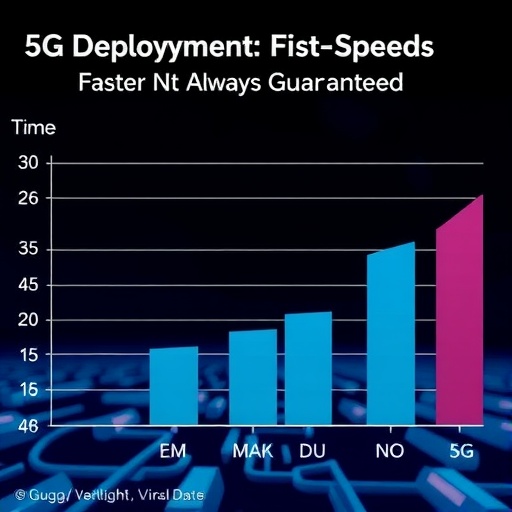The Current State of 5G Implementation: A Mixed Bag of Performance
In the rapidly evolving landscape of telecommunications, 5G has become a household name, heralded as the next great leap in wireless connectivity. However, as the industry begins to turn its gaze towards the next generation—6G—it prompts a critical examination of 5G’s actual implementation and effectiveness. An extensive year-long study, spearheaded by an international research team from Northeastern University, endeavors to shed light on the current state of 5G deployment across various urban centers in Europe and North America. The findings paint a nuanced and somewhat sobering picture of 5G’s capabilities in practice.
The study covers a diverse array of urban environments, with data collected from eight cities: Berlin, Turin, Oslo, Porto, Madrid, Vancouver, Boston, and the Bay Area. Using a combination of controlled measurements and crowdsourced data, the researchers aimed to assess the real-world performance of 5G networks as compared to their 4G predecessors. Surprisingly, their findings reveal that while 5G infrastructure is prevalent in major urban centers, the real-world performance does not universally surpass that of 4G networks. Instead, the benefits of 5G often fluctuate depending on geographic and operational variables.
Imran Khan, a predoctoral researcher at Northeastern University and the principal author of the study, elaborates on this discrepancy, noting the marked geographical and operator-level variations in 5G capabilities. Some networks demonstrated excellent uplink performance, while others offered negligible improvements over existing LTE services. This unevenness suggests that factors affecting network performance are far more intricate than merely the introduction of new technology. Operator-specific choices surrounding factors like spectrum band allocation, network deployment density, and the usage of cloud and edge infrastructure play pivotal roles in determining how well 5G performs in real-world settings.
Claudio Fiandrino, a Research Assistant Professor at IMDEA Networks, further distills the essence of the findings, indicating that the deployment of 5G networks in urban landscapes has reached a form of stabilization. However, this stabilization has not yet translated into universally superior performance metrics—specifically in terms of latency—compared to 4G/LTE technology. This inconsistency between marketing promises and real-world outcomes poses challenges for consumers, who may find that switching to 5G does not guarantee enhanced responsiveness or lowered latency for their applications.
The study highlights that many users’ experiences with 5G do not align with the anticipated benefits purported by promotional campaigns. For critical applications that rely on low latency, the variability in performance across different networks and locations becomes a significant concern. The conclusion drawn by researchers is that decisions regarding the use of latency-sensitive services should stem from solid measurements and analyses, rather than mere assumptions based on the generational advancements in technology.
Furthermore, the study raises cautionary flags regarding the rushed transition to 6G. It emphasizes the potential dangers of channeling investments into next-generation technologies before fully resolving existing operational challenges. Issues like coverage gaps, backhaul and edge location optimization, and spectrum fragmentation could easily go unaddressed if resources are misallocated in pursuit of new technologies. The researchers caution that such missteps could lead to unmet public expectations and a loss of trust in the telecommunications industry as a whole.
It becomes clear that the key to ensuring that future generations of wireless technology fulfill their promises lies in large-scale, forward-looking measurement initiatives. These efforts must prioritize transparency and reproducibility to meaningfully assess user experiences. The researchers advocate for a more measured approach to policy-making and investment strategies in the realm of 6G, stressing that actual performance data should guide decisions rather than unsubstantiated projections and marketing rhetoric.
Despite the anticipated maturity of 5G in major urban environments, the findings underscore that we are still in a phase where performance advantages—in particular, latency—remain inconsistent across different networks. As Fiandrino points out, while 5G coverage and deployment stability appear robust, the technology has not yet matured to a point where it delivers uniformly superior user experiences in comparison to 4G. Thus, the development of telecommunications technology must not only focus on deployment metrics but also ensure that reliability and user experience become top priorities.
Ultimately, the exploration of 5G’s current state reveals a technological landscape marked by both promise and challenge. While the infrastructure is largely in place, the urgent need to enhance the real-world application and user experience persists. The integrity of future networks, particularly with the advent of 6G, hinges on addressing these immediate concerns and fostering a transparent dialogue about technological capabilities.
As we navigate this period of transition in telecommunications, it is crucial to foster public understanding of what these advancements signify. 5G has indeed laid the groundwork for future developments, but only by committing to ongoing assessments and improvements can the industry hope to realize the full potential of next-generation connectivity.
In summary, while 5G is undeniably deployed widely in urban centers, its performance advantages over 4G are far from guaranteed. The observed variances in network performance emphasize the importance of empirical data in guiding both operator decisions and user expectations. The telecommunications sector must approach the impending shift to 6G with caution, ensuring that it learns from the lessons of 5G’s rollout to create a more reliable and user-centric technological future.
Subject of Research: State of 5G Implementation and Comparison with 4G
Article Title: The Current State of 5G Implementation: A Mixed Bag of Performance
News Publication Date: October 2023
Web References: N/A
References: N/A
Image Credits: N/A
Keywords: 5G, telecommunications, latency, network performance, 6G, urban centers, user experience, empirical data, infrastructure, technology evaluation.
Tags: 5G deployment challenges5G implementation effectiveness5G vs 4G speed assessmentcrowdsourced data in telecommunications researchfuture of wireless technology 6Ggeographic variability in 5Gmixed results of 5G networksNortheastern University telecommunications researchreal-world 5G performance comparisontelecommunications research studyurban 5G infrastructure analysisurban center connectivity analysis





